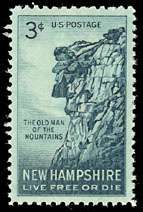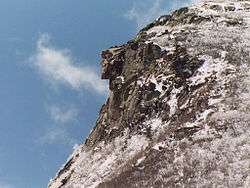Old Man of the Mountain
 A composite image of the Old Man of the Mountain created from images taken before and after the collapse. |
 The reverse of the state quarter of New Hampshire features the Old Man of the Mountain, alongside the state motto 'Live Free or Die'.  U. S. stamp issued in 1955. Plural version of the name is unusual. |
The Old Man of the Mountain, also known as the Great Stone Face or the Profile,[1] was a series of five granite cliff ledges on Cannon Mountain in the White Mountains of New Hampshire, United States, that appeared to be the jagged profile of a face when viewed from the north. The rock formation was 1,200 feet (370 m) above Profile Lake, and measured 40 feet (12 m) tall and 25 feet (7.6 m) wide. The site is located in the town of Franconia.
The first recorded mention of the Old Man was in 1805. It collapsed on May 3, 2003.[2]
History
The formation was carved by glaciers and was first recorded as being discovered by a surveying team around 1805. The official state history says several groups of surveyors were working in the Franconia Notch area at the time and claimed credit for the discovery.
The Old Man was famous largely because of statesman Daniel Webster, a New Hampshire native, who once wrote: "Men hang out their signs indicative of their respective trades; shoe makers hang out a gigantic shoe; jewelers a monster watch, and the dentist hangs out a gold tooth; but up in the Mountains of New Hampshire, God Almighty has hung out a sign to show that there He makes men."
The writer Nathaniel Hawthorne used the Old Man as inspiration for his short story "The Great Stone Face", published in 1850, in which he described the formation as "a work of Nature in her mood of majestic playfulness".
The profile has been New Hampshire's state emblem since 1945.[3] It was put on the state's license plate, state route signs, and on the back of New Hampshire's Statehood Quarter, which is popularly promoted as the only US coin with a profile on both sides. Before the collapse, it could be seen from special viewing areas along Interstate 93 in Franconia Notch State Park, approximately 80 miles (130 km) north of the state's capital, Concord.
Collapse

Freezing and thawing opened fissures in the Old Man's forehead. By the 1920s, the crack was wide enough to be mended with chains, and in 1957 the state legislature passed a $25,000 appropriation for a more elaborate weatherproofing, using 20 tons of fast-drying cement, plastic covering, and steel rods and turnbuckles, plus a concrete gutter to divert runoff from above. A team from the state highway and park divisions maintained the patchwork each summer.[4]
Nevertheless, the formation collapsed to the ground between midnight and 2 a.m., May 3, 2003.[2] Dismay over the collapse was so great that people left flowers at the base of the cliffs in tribute. In 2004, the state legislature considered, but did not accept, a proposal to change New Hampshire's state flag to include the profile.[5]
After collapse
Early after the collapse, many New Hampshire citizens considered replacement with a replica. That idea was rejected by an official task force in 2003 headed by former Governor Steve Merrill.[6]
On the first anniversary of the collapse in May 2004, the Old Man of the Mountain Legacy Fund (OMMLF) began operating coin-operated viewfinders near the base of the cliff. When looking through them up at the cliff of Cannon Mountain one can see a "before" and "after" of how the Old Man of the Mountain used to appear.[2]
Seven years after the collapse, on June 24, 2010, the OMMLF, now the Friends of the Old Man of the Mountain, broke ground for the first phase of the state-sanctioned "Old Man of the Mountain Memorial" to be located on an improved walkway along Profile Lake below Cannon Cliff. The first phase consists of a viewing platform with "Steel Profilers", which, when aligned with the Cannon Cliff above, create what the profile looked like up on the cliff overlooking the Franconia Notch. The second phase will include a "Granite Gateway" with tribute to the Nielsen family and others who maintained the profile over the last century. It will also include a remnant of the turnbuckle tie rod that supported the uppermost ledge. In the third and final phase, five large "Granite Monoliths" were to be lifted in alignment, which when viewed from ground level would merge, creating a 20-foot-tall (6.1 m) profile replica of the five ledges that generated the original profile. The project was being overseen by Friends of the Old Man of the Mountain/Franconia Notch,[7] a committee that succeeded the Old Man of the Mountain Revitalization Task Force. The Legacy Fund is a private 501(c)(3) corporation with representatives from various state agencies and several private nonprofits.[8]
In 2013, contributions ended. The board called a halt to further attempts at fundraising. They announced their intention to spend what was left on minor improvements and dissolve the board.[6]
Other proposals that were considered but rejected include:
- Architect Francis Treves envisioned a walk-in profile made of 250 panels of structural glass attached to tubular steel framework and concrete tower, connected by a tram, rim trail or tunnel through to the cliff wall at the original site. It won an American Institute of Architects Un-Built Project Award.[9][10]
- In 2009, Kenneth Gidge, a state representative from Nashua, proposed building a copper replica of the Old Man on level ground above the ledge at the original site where hiking trails already lead.[11]
Timeline of the Old Man
Details of the history of the Old Man of the Mountain include:[12]
- 17th millennium BC–6th millennium BC — New England undergoes the Wisconsin glaciation, the most recent ice age. Glaciers cover New England and post-glacial erosion creates the cliff which would subsequently erode into the Old Man of the Mountain at Franconia Notch.
- 1805 — Francis Whitcomb and Luke Brooks, part of a Franconia surveying crew, are the first white settlers to record observing the Old Man, according to the official New Hampshire history.
- 1832 — Author Nathaniel Hawthorne visits the area.
- 1850 — Hawthorne publishes "The Great Stone Face", a short story inspired by his visit. The story's title becomes an alternative name for the formation.
- 1869 — President Ulysses S. Grant visits the formation.
- 1906 — The Reverend Guy Roberts of Massachusetts is the first to publicize signs of deterioration of the formation.
- 1916 — New Hampshire Governor Rolland H. Spaulding begins a concerted state effort to preserve the formation.
- 1945 — The Old Man is made the New Hampshire State Emblem.[3]
- 1955 — President Dwight D. Eisenhower visits the profile as part of the Old Man's 150th "birthday" celebration.
- 1958 — Major repair work to the Old Man's forehead as a result of a legislative appropriation the previous year.
- 1965 — Niels Nielsen, a state highway worker, becomes unofficial guardian of the profile, in an effort to protect the formation from vandalism and the ravages of the weather.[13]
- 1986 — Vandalizing the Old Man is classified as a crime under the state criminal mischief law. Under the law (RSA 634:2 VI) it is a misdemeanor for any person to vandalize, deface or destroy any part of the Old Man, with a penalty of a fine of between $1,000 and $3,000 and restitution to the state for any damage caused.[14]
- 1987 — Nielsen is named the official caretaker of the Old Man by the state of New Hampshire.
- 1988 — A 12-mile (19 km) stretch of Interstate 93 (which also runs jointly with U.S. Route 3 through the notch) opens below Cannon Mountain. The $56 million project, which took 30 years to build, was a compromise between desire for a four-lane interstate and those who sought to limit impact on the notch.
- 1991 — David Nielsen, son of Niels Nielsen, becomes the official caretaker of the Old Man.
- 2000 — The Old Man is featured on the state quarter of New Hampshire.
- 2003 — The Old Man collapses.[2]
- 2004 — Coin-operated viewfinders are installed to show how the Old Man looked before its collapse.[2]
- 2007 — Design of an Old Man of the Mountain memorial announced.
- 2010 — First phase of the state-sanctioned "Old Man of the Mountain Memorial" is unveiled.
See also
- List of rock formations that resemble human beings
- Pareidolia
- Cydonia, location of the "Face on Mars"
References
- ↑ "Franconia Notch". Encyclopædia Britannica. Chicago, Illinois: Encyclopædia Britannica, Inc. 2008. Retrieved 2008-01-31.
- 1 2 3 4 5 New Hampshire Division of Parks and Recreation: Old Man of the Mountain Historic Site Accessed: 14 August 2012.
- 1 2 "NH.gov – New Hampshire Almanac – State Emblem".
- ↑ Daniel Ford, The Country Northward (1976), p. 52.
- ↑ J. Dennis Robinson (Feb 27, 2004). "Save the Seal, Keep the Ship". SeacoastNH.com. Retrieved July 6, 2010.
- 1 2 Governor Steve Merrill. "Old Man of the Mountain Has Fallen – What Next?". Retrieved June 27, 2014.
- ↑ Lorna Colquhoun (June 25, 2010). "Old Man's profile makes return". New Hampshire Union Leader. Retrieved July 6, 2010.
- ↑ "Old Man of the Mountain Legacy Fund". Old Man of the Mountain Legacy Fund. Retrieved July 6, 2010.
- ↑ Garry Rayno (April 24, 2009). "Designer: Replace Old Man with walk-in glass replica". New Hampshire Union-Leader. Retrieved July 20, 2010.
- ↑ "Redefinition of the Old Man of the Mountain". Francis Treves, AIA. April 26, 2010. Retrieved May 3, 2010.
- ↑ Edge Mugga (January 7, 2009). "New Hampshire Proposal to Rebuild the Old Man of the Mountain: HB 192". Edge-On Blog. Retrieved July 6, 2010.
- ↑ "Old Man Of The Mountain Legacy Fund : Historical Timeline".
- ↑ "Old Man Timeline". New Hampshire Division of Parks and Recreation. Retrieved March 28, 2010.
- ↑ "Title LXII, Criminal Code, Chapter 634, Destruction of Property, Section 634:2". New Hampshire General Court. Retrieved July 6, 2010.
External links
| Wikimedia Commons has media related to Old Man of the Mountain. |
- NH State Parks — Old Man of the Mountain Historic Site
- The Old Man of the Mountain Memorial
- The Old Man of the Mountain Legacy Fund
- Photos from atop the Old Man of the Mountain after the collapse
- 19th-century paintings of the Old Man of the Mountain
Coordinates: 44°09′38″N 71°41′00″W / 44.1606203°N 71.6834169°W